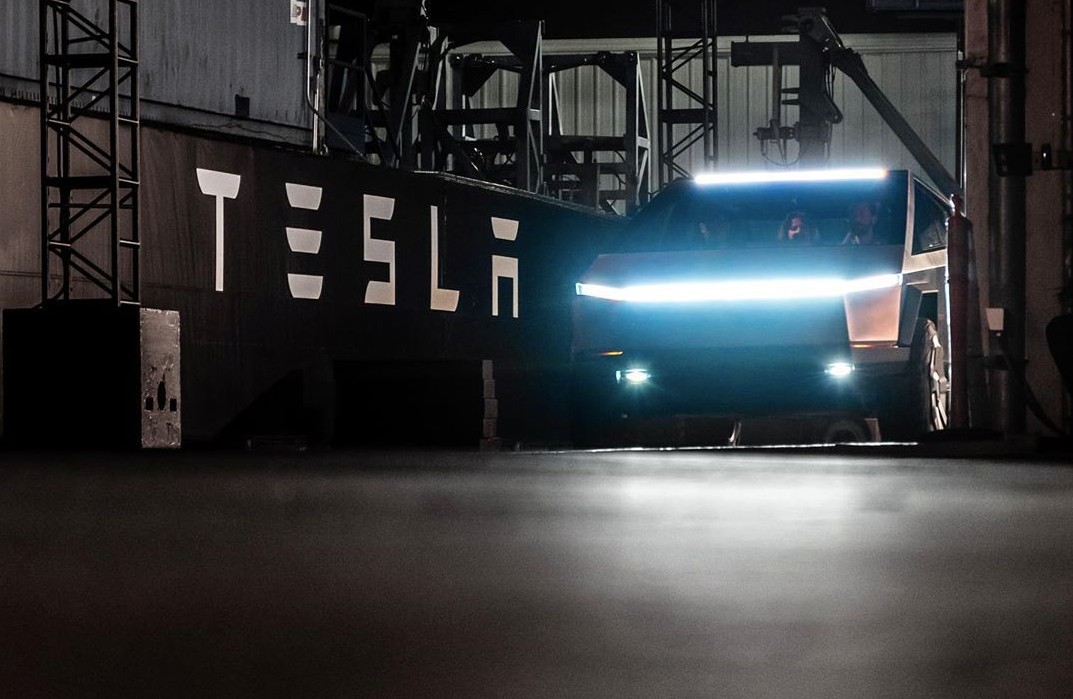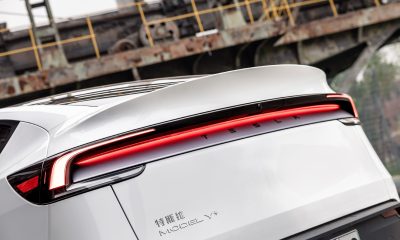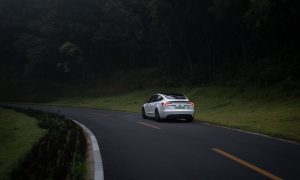

News
Tesla Cybertruck’s ‘V4′ charging hints at Plaid Model S’ monster peak charge rate
During the Tesla Cybertruck’s unveiling last November, CEO Elon Musk subtly commented that the all-electric pickup would be capable of charging at more than 250 kW. Musk did not disclose any other details about the Cybertruck’s possible “V4” Supercharging support, though the innovations that make it possible may very well be tailor-fit for the company’s next-generation of vehicles like the Plaid Model S and Plaid Model X.
The mention of the Cybertruck’s peak charge rate came at the latter part of the vehicle’s unveiling. Unfortunately, Elon Musk was already a bit shaken then due to the vehicle’s failed Armor Glass demonstration. Thus, the CEO’s mention of the key feature almost sounded like an afterthought, with Musk simply stating that the Cybertruck will “be capable of more than 250 kW.” He also mentioned that Tesla will “reveal the actual number later.”
In a way, an improved peak charge rate for the Cybertruck that goes beyond 250 kW is very well within character for the electric car maker. Tesla, after all, appears to be in the habit of introducing upgraded charging systems with every generation of its vehicles. The company’s first and second-generation 120 kW Superchargers were rolled out alongside the ramp of the Model S and Model X, and the 250 kW Supercharger V3 was introduced to support the ramp of the higher volume Model 3 and the Model Y.
With this in mind, there seems to be a pretty good chance that Tesla is preparing “V4” Superchargers for its next generation of vehicles. Tesla’s coming electric cars are expected to have the company’s best and possibly largest battery packs to date, after all, as represented by the Plaid Model S, Plaid Model X, Cybertruck, and perhaps even the Semi. Considering Tesla’s pace of innovation, it may not be surprising if the company’s peak charge rate for the Cybertruck, Plaid Model S, and Plaid Model X ends up being on par or higher than 350 kW.
This who have followed Elon Musk’s tweets over the past years would remember a post back in December 2016 when the CEO mentioned that a peak charge rate of 350 kW was more akin to a “children’s toy.” Musk’s statement may simply be a playful jab at the 350 kW peak charge rates of other charging networks, such as IONITY in Europe and Electrify America, but it does hint that the electric car maker is considering the introduction of a charging system that peaks beyond 350 kW. Since very few vehicles today like the Porsche Taycan are capable of supporting 350 kW charging, a “V4” Supercharger that goes beyond 350 kW would allow Tesla to leapfrog its competitors once more.
Such a strategy is actually well within character for the electric car maker, seeing as the company also has a tendency to give competitors a short-lived edge before leapfrogging them. This was the case with the Taycan’s track capability, which was designed to overcome and crush the capabilities of the Model S. Following the Taycan’s unofficial record run at the Nurburgring, Elon Musk announced that the flagship Tesla sedan was taking on the notorious track too, and sure enough, the Plaid Model S completely walked over the Taycan’s unofficial record.
That being said, and with Tesla’s tendency to innovate in mind, it appears safe to assume that the current V3 Superchargers still have a long way to go. The 250 kW chargers are still quite early in their rollout, and thus, Tesla is almost certain to upgrade them and increase their peak charge capabilities in the future. That was the strategy that the company adopted for its V2 Superchargers, which could now charge up to 150 kW. Regardless of whether the Cybertruck’s over 250 kW peak charge rate is due to a “V4” or an upgraded V3 Supercharger, however, there is very little doubt that the next generation of EV fast chargers will be dominated by Tesla once more.
Elon Musk
Elon Musk confirms Grok 4 launch on July 9 with livestream event
The rollout will be accompanied by a livestream at 8 p.m. Pacific Time.

Elon Musk has officially confirmed that Grok 4, the latest version of xAI’s large language model, will launch on July 9. The rollout will be accompanied by a livestream at 8 p.m. Pacific Time, hosted on xAI’s official account on X.
xAI goes straight to Grok 4
Back in May, leaks indicated that xAI was getting ready to ship Grok 3.5. Considering Musk’s recent comments, however, it appears that the artificial intelligence startup would be focusing on the large language model’s fourth iteration instead. As noted in a Financial Express report, users on X have sighted references to Grok 4 in the lead up to the update’s launch, such as “grok-4-prod-mimic” and “Grok 4 Code.”
Musk’s Grok 4 announcement comes as AI competition intensifies between major players including OpenAI, Google, and xAI. With Musk’s Colossus supercomputer fully operational in Memphis, xAI appears to be accelerating its AI product roadmap.
Musk pushes Grok toward political neutrality
Grok 4’s launch also follows a recent controversy involving political bias, as noted in a CNN report. Last week, Grok responded to a user on X stating that political violence in the U.S. since 2016 had come more from the political right than the left. The chatbot noted in a later reply that its answer was based on information from sources like Reuters, the Journal of Democracy, and University of Maryland studies.
Musk stated that Grok’s response was a “major fail.” “Major fail, as this is objectively false. Grok is parroting legacy media. Working on it,” he wrote in a post on X. By the end of June, Musk noted that he was “grinding all night with the xAI team” and that they were making “good progress.” He also stated that the model “Will be called Grok 4. Release just after July 4th. Needs one more big run for a specialized coding model.”
News
Tesla opens massive solar Supercharger station in California
The Supercharger opened to customers ahead of Fourth of July weekend, while Tesla continues phase two of construction on the site.

Tesla has officially launched the first several Supercharging posts at a massive station in California, notably including solar canopies and grid-scale batteries to offer completely renewable charging.
Last week, Tesla announced on X that it opened the first 84 Supercharger stalls of a planned 168-stall station in Lost Hills, California. Additionally, the massive Supercharger project features 11MW of solar canopies and 10 Megapack batteries for off-grid charging powered entirely by solar energy.
Tesla completed the first phase of the project just days ahead of the busy Fourth of July holiday weekend, adding that initial construction took just eight months. In addition to the remaining charging stalls, Tesla says it’s building a set of lounge areas, renderings of which can be seen below alongside current photos of the site.
Notably, the site also includes V4 charging posts for the company’s latest available charging speeds, and it’s located near the busy junction between I-5 and Highway 46 in Kern County.
“Thank you [Kern County] and [PG&E] for collaboration and approvals,” Tesla wrote in a follow-up post.

Credit: Tesla Charging | X

Credit: Tesla Charging | X

Credit: Tesla Charging | X

Credit: Tesla Charging | X
Tesla Supercharger Maps for North America, Europe, and Asia pic.twitter.com/0U5r0XRPyo
— TESLARATI (@Teslarati) July 2, 2025
READ MORE ON TESLA SUPERCHARGERS: Tesla launches ultra-fast V4 Superchargers in China for the first time
Testing at the LA Diner, plus Musk update on potential Tesla solar Gigafactory
The huge Tesla Supercharger station completed phase one of construction fairly quickly, especially given how long Tesla has been working on its unique Los Angeles diner, drive-in, and Supercharger location. Still, the company was seen performing some testing at the nearly-completed charging station earlier this month, and will reportedly be holding a job fair.
Elon Musk also responded on Monday morning to a post on X, suggesting that Tesla is “thinking about” building a U.S.-based solar Gigafactory in order to help support increased power needs with AI growth, and to bolster domestic solar production.
Tesla is building a new UFO-inspired Supercharger in the heart of Alien country
News
Tesla driver walks away from major accident with minor injuries
The driver sustained only minor injuries, and the exact cause of the crash remains under investigation.

The driver of a Tesla Model Y survived and walked away from a harrowing accident on Monday in California, only sustaining minor injuries despite the vehicle being impaled by a guardrail.
On Monday morning around 4:34 a.m., the Los Banos division of the California Highway Patrol (CHP) responded to the accident on I-5 near Panoche Road, involving a 23-year-old in a Tesla Model Y. According to a post on social media, the driver veered off the road for unknown reasons in the northbound lane, before crashing directly into the guardrail and impaling the vehicle.
You can read the full message and photos from Los Banos CHP below, as were shared in a Facebook post on Monday afternoon.
This morning a Tesla model y was traveling in the #1 northbound lane of I-5 north of Panoche Rd. For unknown reasons driver allowed V-1 to veer off the roadway, travel through a dirt center divide, and crashed into the fixed metal guardrail. Lucky for the driver he only sustained minor injuries and was able to walk away. Driving a vehicle requires 100% attention to the road. Avoid distractions and focus on driving.

Credit: CHP Los Banos (via Facebook)

Credit: CHP Los Banos (via Facebook)

Credit: CHP Los Banos (via Facebook)
In a statement to SFGate, CHP officer Myles Anderson said that the driver only sustained minor injuries, while no arrests are made and drugs and alcohol are not suspected to have been involved. The report also notes that Tesla’s “cruise control and lane assistance features” were activated, according to Anderson. However, it’s not entirely clear if this is referring to Supervised Full Self-Driving (FSD), or to the cruise control and lane assist features baked into Autopilot.
At the time of writing, CHP has not yet responded to Teslarati’s request for clarification and additional details on the matter.
Tesla Crash Safety Ratings across its lineup: pic.twitter.com/ny30R7ceji
— TESLARATI (@Teslarati) July 1, 2025
READ MORE ON TESLA SAFETY: Tesla rolls out crucial new safety feature aimed at saving children
The news comes after Tesla has touted its vehicles as incredibly safe for many years. In December, for example, the company highlighted receiving top safety scores from regulators on four different continents throughout the world, including from the National Highway Traffic Safety Administration (NHTSA) and the Insurance Institute of Highway Safety (IIHS) in the U.S.
Tesla has also listed the goal of making its vehicles the safest on the road throughout the years, both in the overall design of its vehicles and in its Autopilot and Full Self-Driving (FSD) programs.
Tesla Model 3 ranks as the safest new car in Europe for 2025, per Euro NCAP tests
-

 Elon Musk1 week ago
Elon Musk1 week agoTesla investors will be shocked by Jim Cramer’s latest assessment
-

 News2 weeks ago
News2 weeks agoTesla Robotaxi’s biggest challenge seems to be this one thing
-

 News2 weeks ago
News2 weeks agoWatch the first true Tesla Robotaxi intervention by safety monitor
-

 Elon Musk2 weeks ago
Elon Musk2 weeks agoA Tesla just delivered itself to a customer autonomously, Elon Musk confirms
-

 News2 weeks ago
News2 weeks agoTesla Robotaxi rollout proves that Elon Musk still delivers, even if it’s late
-

 Elon Musk2 weeks ago
Elon Musk2 weeks agoxAI welcomes Memphis pollution results, environmental groups push back
-

 Elon Musk2 weeks ago
Elon Musk2 weeks agoElon Musk commends Tesla team on successful Robotaxi launch
-

 Elon Musk2 weeks ago
Elon Musk2 weeks agoElon Musk confirms Tesla Optimus V3 already uses Grok voice AI


















